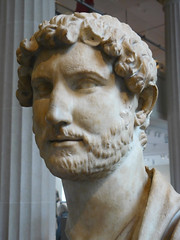Israeli archaeologists have uncovered an 1800-year-old bathing pool used by the Roman Tenth Legion and dating from the second and third centuries AD in the old Jewish Quarter of Jerusalem known by the Romans as Aelia Capitolina.
The archaeology excavations revealed several plastered bathtubs in the side of the pool, a pipe used to fill it with water, and a white industrial mosaic on the floor of the pool.
The bathhouse tiles, stamped with the symbols "LEG X FR" - Tenth Legion Fretensis - were found in place and the paw print of a dog which probably belonged to one of the soldiers was impressed on the symbol of the legion on one of the roof tiles.
The Legio X Fretensis ("Tenth legion of the sea strait"), had been stationed in Judea after the Great Jewish Revolt in 70 CE. Jewish unrest, however, continued to plague the Roman provincial government. Hostilities finally erupted again after Hadrian announced he would rebuild the Jews holiest city as a Roman metropolis, ploughing up the remains of Herod's temple (The Second Temple) and replacing it with a temple of Jupiter. The leader of the revolt, Simon bar Kokhba was thought to be a Jewish messiah and rebels announced the "era of redemption of Israel". Over 580,000 Jews were killed during the Bar Kokhba revolt (132–136 CE) and 50 fortified towns and 985 villages razed. Bar Kokhba as well as ten leading members of the Sanhedrin were executed and thereafter Hadrian prohibited Torah law and the Hebrew calendar.
Modern historians have come to view the Bar-Kokhba Revolt as being of decisive historic importance. The massive destruction and loss of life occasioned by the revolt has led some scholars to date the beginning of the Jewish diaspora from this date. They note that, unlike the aftermath of the First Jewish-Roman War chronicled by Josephus, the majority of the Jewish population of Judea was either killed, exiled, or sold into slavery after the Bar-Kokhba Revolt, and Jewish religious and political authority was suppressed far more brutally. After the revolt the Jewish religious center shifted to the Babylonian Jewish community and its scholars.
For more interesting topics related to archaeology, visit archaeology excavations.
Archaeology excavation is best known and most commonly used within the science of archaeology. In this sense it is the exposure, processing and recording of archaeological remains.
Sunday, June 26, 2011
Cleaning up after the Bar Kokhba revolt
Subscribe to:
Post Comments (Atom)


No comments:
Post a Comment